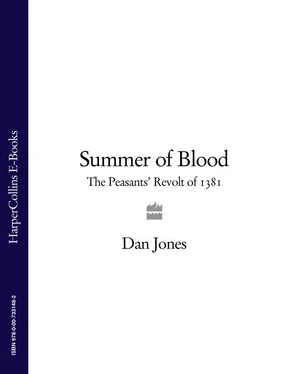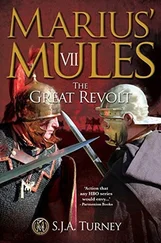Outside London, the rebellious spirit proved infectious, and there were major revolts in Essex, Kent and East Anglia, as well as more isolated riots and urban disorder in Somerset, Sussex, Oxfordshire, Leicestershire and Yorkshire. Even once the troubled summer had faded into autumn, plotting continued throughout England, and the subject of lower-order resistance, present in literature from the middle of the fourteenth century, became a real concern for the well-to-do.
In short, the rebellion was both a comprehensive damnation of English government and a startling announcement of the new political consciousness of the common folk of England. The lower orders, who had for generations been treated by the landed and powerful as little more than beasts of burden and battlefield fodder, showed themselves to be dangerous, politically aware, and capable both of independent military organisation and blistering anger. England’s nobility, merchants, lawyers and wealthy churchmen-most of whom had long suspected in the labouring class a tendency to viciousness-were confirmed in all their worst fears. The revolt marked the beginning of a rebellious tradition among the English lower orders which has been repeated ever since-from Jack Cade’s rebels in 1450 to Robert Ket’s in 1549; from Lord Gordon’s riots in 1780 to the famous ‘poll tax’ rebellion of our own time, in the early spring of 1990.
Over the centuries, the Peasants’ Revolt-to use the slightly misleading shorthand that historians have given the rebellion-has found its place in the corpus of great events in English history. The year 1381 is a signpost on the road from the battle of Hastings in 1066 and Magna Carta in 1215 to Bosworth in 1485, the Armada in 1588 and everything beyond.
But what do we really know about it?
The truth is that, as with many historical phenomena, telling the whole story of the revolt can be like trying to nail a jelly to the wall. The sources are fragmentary, incomplete and strongly slanted in favour of the rebels’ victims. The revolt’s causes-economic, social, political and legal-were myriad, and its geographical spread was wide. The terror that was struck into the hearts of those who recorded the revolt has lingered on. England’s monastic chroniclers recorded the rebels’ crimes and England’s lawyers documented their punishments. All did so with extreme prejudice, smearing the memories of the hated peasants with the ordure of their disgust, and staining the historical memory of the revolt with class hatred. Partly as a consequence, this class dimension has, over the years, attracted historians with a greater interest in applying historical theory than in fulfilling the historian’s most important duty: to tell, as accurately as possible, a cracking good story. 4
This book is an attempt to redress the balance: to bring back to life one of the most colourful episodes in our history. In 1381 the peasants burst onto the historical record, and they left, for all the prejudice of their victim-biographers, a wealth of vivid, violent, hysterical and occasionally hilarious reactions to posterity. Their story is a frenzied, bloodied trip into an under-explored period of English history. And its inevitable, gory conclusion-both tragic and reassuring-is a reminder of the cold truth of revolt: that even the most righteous rebels usually end up with their heads on spikes.
In writing this new narrative of the revolt, I have aimed to make the causes succinct, the action as vivid as it was then, and the consequences and vengeance wreaked by a humiliated government as terrible as they seemed to a chastened people. The result, I hope, is a journey into a world both profoundly different and remarkably similar to our own. The Peasants’ Revolt takes us somewhere dimly lit and obscure: a world that could be unfair and outrageous; where death, pain, disease, discomfort and misery formed the fabric of everyday life for all but the very rich; a world where a large chunk of the population lived in some form of legal bondage to the land; a world of severe discipline and ingrained violence; a world where a man’s last vision might be his own intestines burning in a pile on the ground.
But this was also a world of life, colour and touching humanity, where ambition could take a man from serfdom to prosperity; where charity and social responsibility, as much as chastisement and rebuke, bound lords and their lessers; and where, among the filth, poverty and violence, there was a belief in the potential to make things better. Clearly, this was also a superstitious, deeply hierarchical world, often idiotically governed and ripe with casual brutality. But working on the drafts of this in London between 2007 and 2009, it was occasionally surprising how close it felt!
Dan Jones London, 2009
Конец ознакомительного фрагмента.
Текст предоставлен ООО «ЛитРес».
Прочитайте эту книгу целиком, купив полную легальную версию на ЛитРес.
Безопасно оплатить книгу можно банковской картой Visa, MasterCard, Maestro, со счета мобильного телефона, с платежного терминала, в салоне МТС или Связной, через PayPal, WebMoney, Яндекс.Деньги, QIWI Кошелек, бонусными картами или другим удобным Вам способом.












